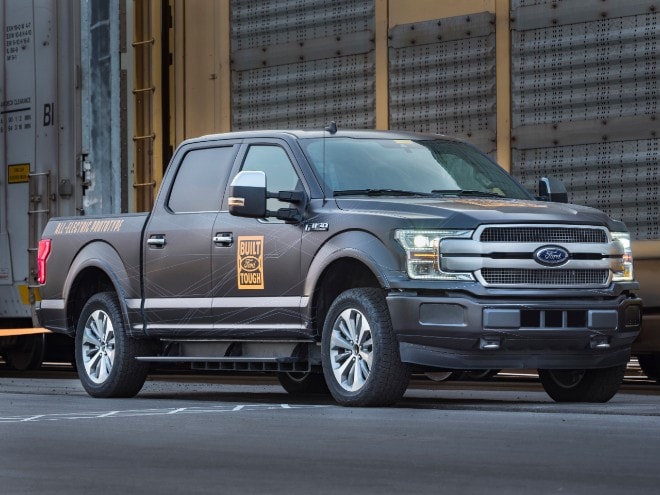
Best-in-class diesel towing: New Ford F-Series Super Duty pickup raises the bar again with best-in-class maximum gooseneck towing of up to 37,000 pounds, best-in-class maximum fifth-wheel towing of 32,500 pounds and best-in-class maximum conventional towing of 24,200 pounds with available 6.7-liter Power Stroke® diesel engine
- Best-in-class diesel power and torque: Available 6.7-liter Power Stroke diesel V8 – the most powerful diesel Ford has ever built – delivers best-in-class 475 horsepower and 1,050 ft.-lbs. of torque, surpassing the 1,000-ft.-lbs. barrier without checking an extra option box
- Best-in-class gas power and torque: All-new available 7.3-liter V8 – the most powerful gas engine ever offered in Super Duty – cranks out best-in-class gas power of 430 horsepower and best-in-class gas torque of 475 ft.-lbs.
- Best-in-class payload: Haul even bigger loads with best-in-class maximum payload capacity of 7,850 pounds with standard 6.2-liter gas engine
2020 F-Series Product Page
DALLAS, Sept. 26, 2019 – Ford F-Series, America’s best-selling truck for 42 consecutive years, is once again delivering for its most demanding and hardworking customers by producing its most capable and powerful heavy-duty pickup ever – the new 2020 F-Series Super Duty.
“Ford truck customers are building a better world with Super Duty and we’re helping them work even harder with the most available diesel towing, payload, torque and power you can get in a heavy-duty pickup,” said Mike Pruitt, Super Duty chief engineer. “We’re excited to be in the nation’s largest truck market at the State Fair of Texas announcing we’ve surpassed the kilotorque barrier and made it standard with every pickup truck featuring a Power Stroke diesel engine.”
Built Ford Tough from the ground up, the new 2020 F-Series Super Duty pickup is an icon of durability and capability. It owns six key best-in-class heavy-duty pickup truck claims for full-size pickups over 8,500 pounds:
Best-in-class maximum available diesel gooseneck towing of up to 37,000 pounds
Best-in-class maximum available diesel fifth-wheel towing of 32,500 pounds
Best-in-class maximum available diesel conventional towing of 24,200 pounds
Best-in-class diesel power and torque with available 6.7-liter Power Stroke® diesel V8 delivering 475 horsepower and 1,050 ft.-lbs.
Best-in-class gas power and torque from all-new available 7.3-liter V8 delivering 430 horsepower and 475 ft.-lbs.
Best-in-class maximum payload capacity of 7,850 pounds with standard 6.2-liter gas engine
To put the capability of Super Duty into perspective, its maximum available towing figure means a properly configured F-450 could tow about as much weight as 31 American quarter horses at 1,200 pounds. That is one big trailer. For 2020, maximum towing capacity increases across all Super Duty pickup series – F-250, F-350 and F-450 – versus the outgoing model.
The 2020 Super Duty with Tremor Off-Road Package is the most capable off-road Super Duty ever. It will have maximum towing of up to 15,000 pounds for conventional trailers and 21,900 pounds for gooseneck trailers with the available diesel, in addition to 4,210 pounds maximum payload capacity with the all-new 7.3-liter gas engine that is available – providing the towing and payload capability customers expect of Super Duty.
With 19 million miles of accumulated testing, Super Duty is designed to stand up to the harshest conditions and heaviest work. Every aspect is torture tested including its high-strength steel boxed frame, high-strength, military-grade, aluminum-alloy body, integrated gooseneck hitch mounts, available all-new 7.3-liter gas V8, available third-generation 6.7-liter Power Stroke diesel and all-new 10-speed heavy-duty TorqShift® automatic. This transmission, available with all engine options, is a critical link in an equation that results in efficient and improved trailering confidence.
A dedication to quality, capability, power and innovation may be why F-Series Super Duty commands the highest market share in demanding industries such as mining, with more than 62 percent, emergency vehicles, with 50 percent, and construction, with more than 47 percent share – according to Ford analysis of IHS Markit TIPNet U.S. registration data, January 2017 through June 2019.
Super Duty also introduces new technology to help improve towing convenience and confidence. New class-exclusive available Pro Trailer Backup Assist makes negotiating even the largest trailers into the tightest of spaces as easy as turning a dial. Following setup, drivers use a knob instead of the steering wheel to easily maneuver the trailer via the reverse camera. Trailer Reverse Guidance shows trailer angle and direction and provides steering suggestions to most efficiently direct a trailer backward. Ford is the only manufacturer to provide Pro Trailer Backup Assist and Trailer Reverse Guidance technology that accommodates all trailer types – conventional, fifth-wheel and gooseneck designs.
Because today’s work is a 24/7 proposition, keeping customers connected is essential. 2020 Super Duty is the only heavy-duty pickup to make connectivity standard with a FordPass Connect™ embedded 4G LTE modem with Wi-Fi access for up to 10 devices to keep crews in communication no matter where the job might take them. Modern touches include the addition of wireless charging for compatible mobile phones and USB-C ports to power your devices.
Standard features on XLT and above Super Duty trim levels include Lane-Keeping Alert to help you stay in your lane and Blind Spot Information System with Trailer Coverage to monitor for vehicles in blind spots – even with one next to your trailer. Also standard on XLT and above is Pre-Collision Assist with Automatic Emergency Braking to alert you of potential collisions with vehicles in your path. Should an accident occur, class-exclusive second-row seat belt pretensioners, standard on all Super Duty models, are activated.
2020 Ford F-Series Super Duty is proudly built at Kentucky Truck Plant in Louisville, Kentucky, and Ohio Assembly Plant in Avon Lake, Ohio. Trucks start shipping to dealers by year-end.
About Ford Motor Company
Ford Motor Company is a global company based in Dearborn, Michigan. The company designs, manufactures, markets and services a full line of Ford cars, trucks, SUVs, electrified vehicles and Lincoln luxury vehicles, provides financial services through Ford Motor Credit Company and is pursuing leadership positions in electrification, autonomous vehicles and mobility solutions. Ford employs approximately 194,000 people worldwide. For more information regarding Ford, its products and Ford Motor Credit Company, please visit www.corporate.ford.com.











